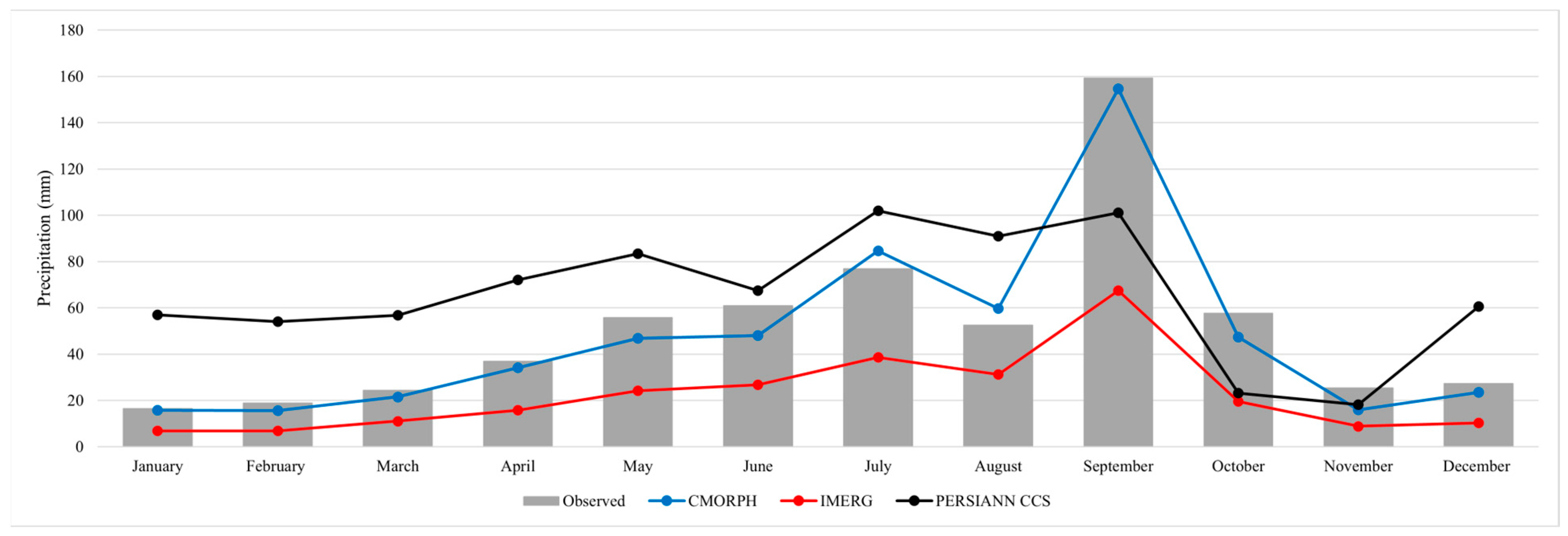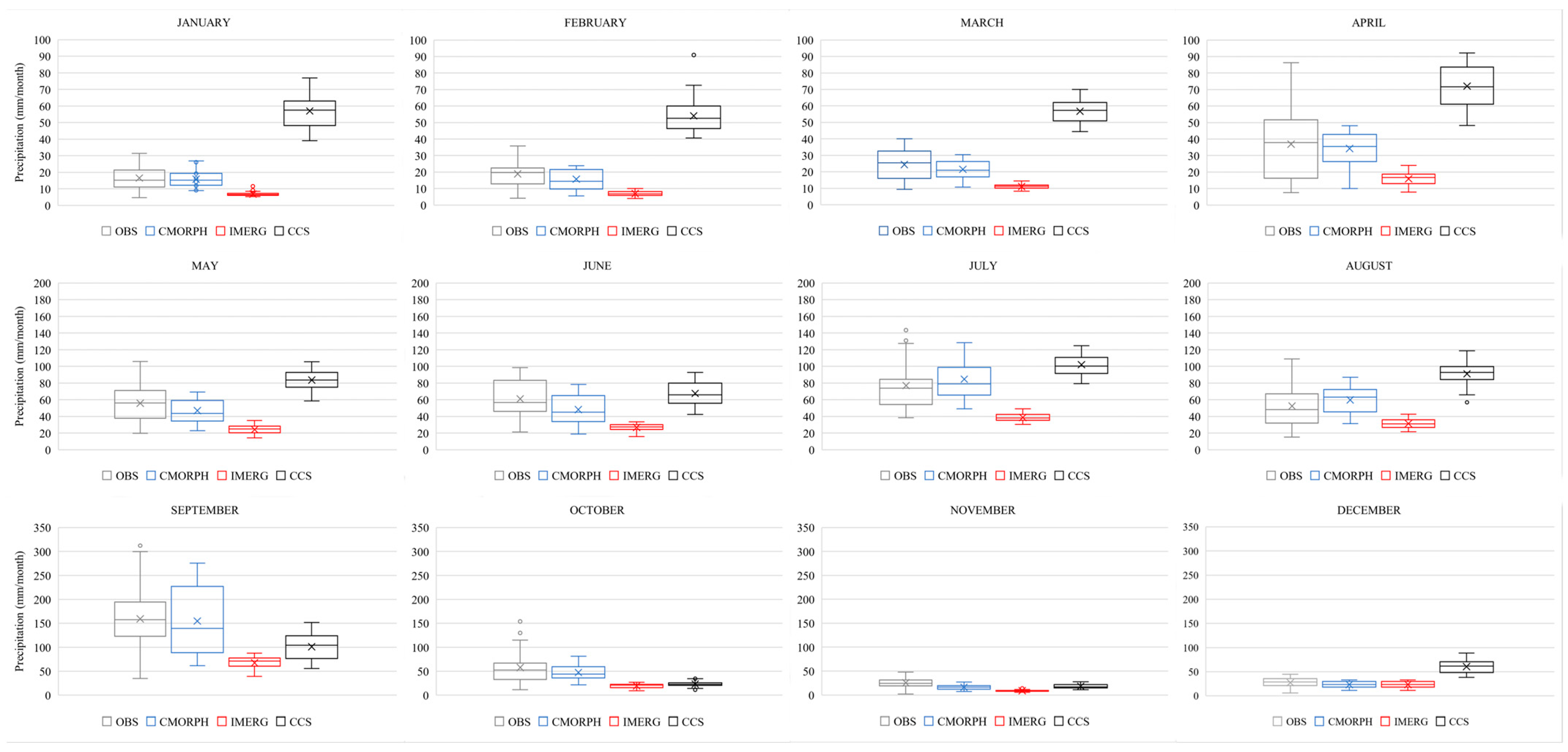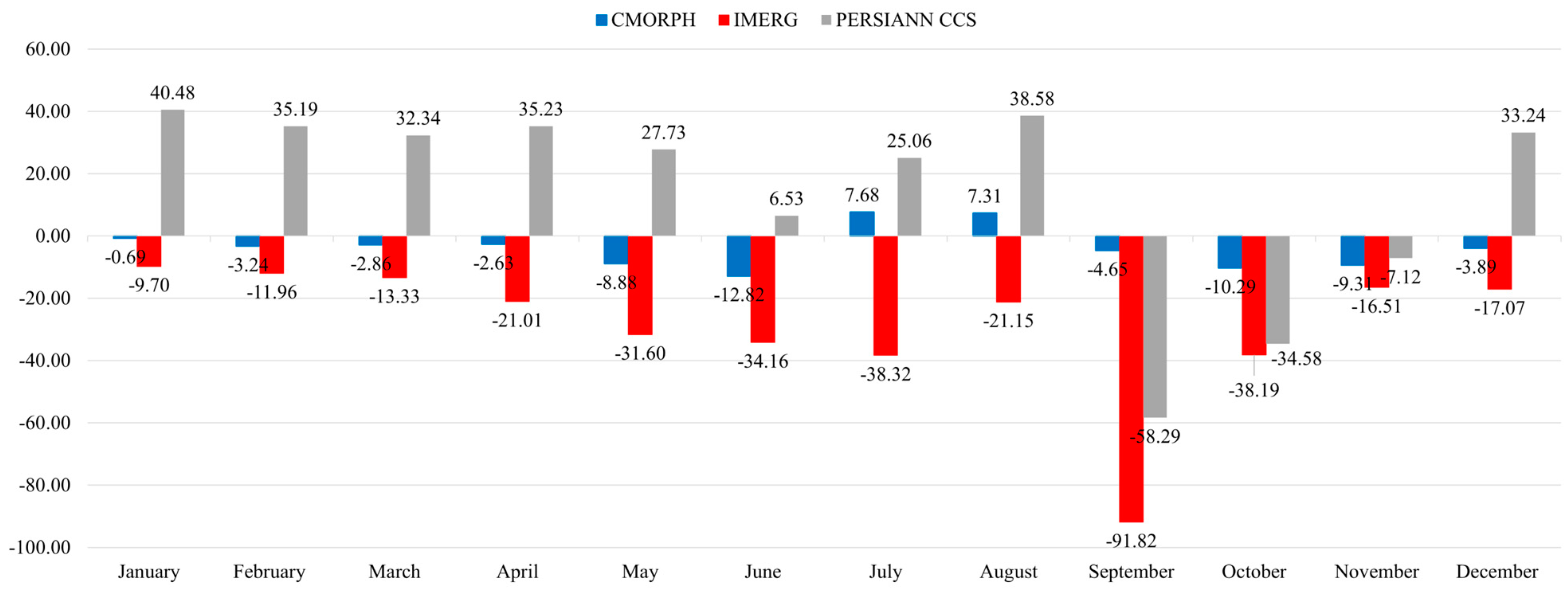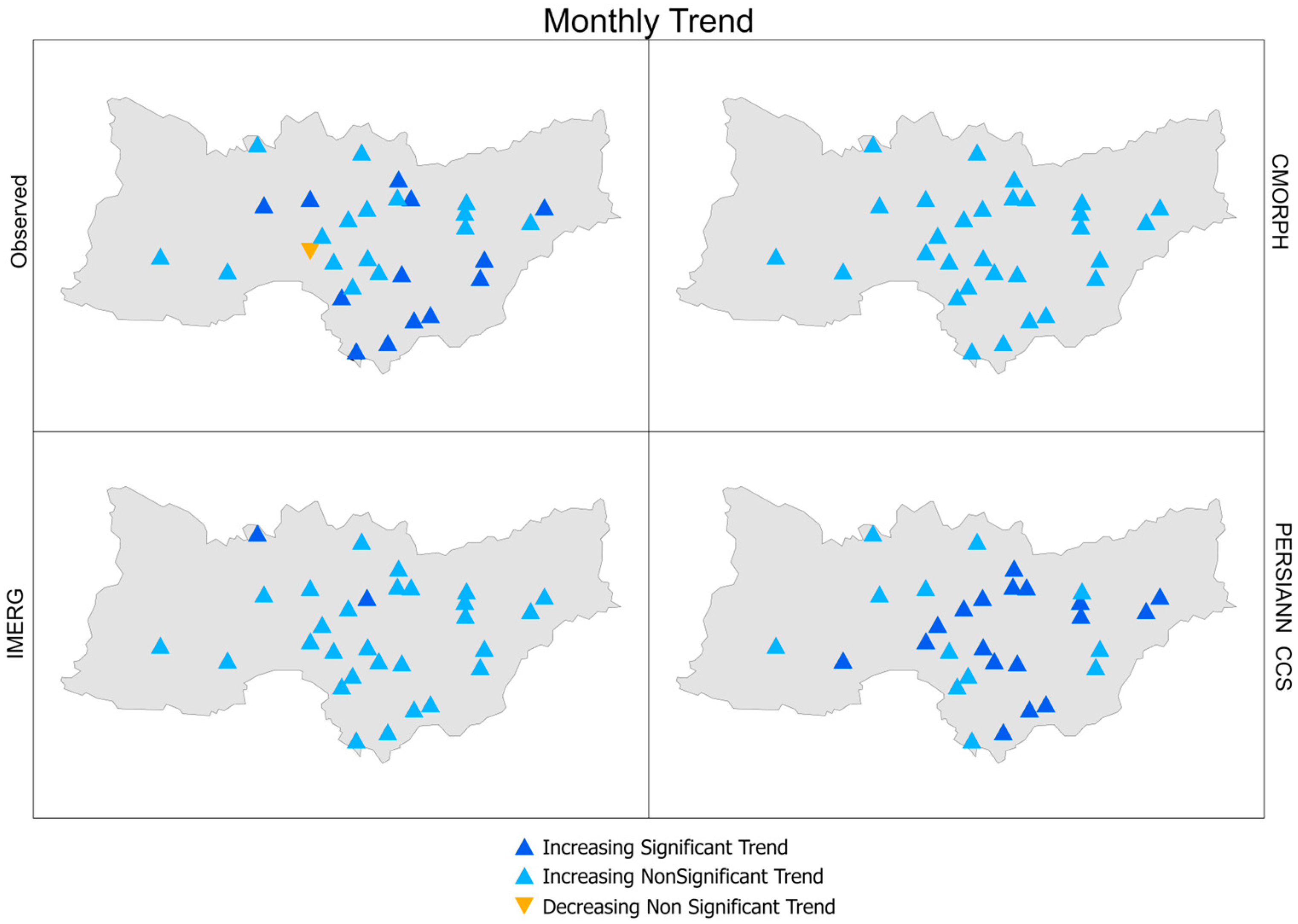Evaluating the Performance and Applicability of Satellite Precipitation Products over the Rio Grande–San Juan Basin in Northeast Mexico
Abstract
:1. Introduction
2. Materials and Methods
2.1. Study Area
2.2. Datasets and Data Processing
| Product | File | Spatial Resolution | Temporal Resolution | Reference | Data Source |
|---|---|---|---|---|---|
| CMORPH | Bin | 0.25° | Daily | [47] | https://ftp.cpc.ncep.noaa.gov/precip/CMORPH_V1.0/ (accessed on 23 June 2022) |
| IMERG | Tif | 0.1° | [48] | https://arthurhouhttps.pps.eosdis.nasa.gov/gpmdata/ (accessed on 21 February 2022) | |
| PERSIANN—CCS | ArcGrid | 0.04° | [46] | https://chrsdata.eng.uci.edu/ (accessed on 15 January 2022) |
2.3. Statistical Evaluation
2.4. Trend Analysis: Mann–Kendall Test
3. Results
3.1. Monthly Estimation Evaluation
3.1.1. Basin Analysis
3.1.2. Station Analysis
3.2. Annual Estimation Evaluation
3.2.1. Basin Analysis
3.2.2. Station Analysis
3.3. Trend Analysis
3.3.1. Monthly
3.3.2. Annually
4. Discussion
5. Conclusions
Author Contributions
Funding
Institutional Review Board Statement
Informed Consent Statement
Data Availability Statement
Acknowledgments
Conflicts of Interest
References
- Yu, L.; Leng, G.; Python, A.; Peng, J. A Comprehensive Evaluation of Latest GPM IMERG V06 Early, Late and Final Precipitation Products across China. Remote Sens. 2021, 13, 1208. [Google Scholar] [CrossRef]
- Dezfooli, D.; Abdollahi, B.; Hosseini-Moghari, S.M.; Ebrahimi, K. A Comparison between High-Resolution Satellite Precipitation Estimates and Gauge Measured Data: Case Study of Gorganrood Basin, Iran. J. Water Supply Res. Technol. 2018, 67, 236–251. [Google Scholar] [CrossRef]
- Kazemzadeh, M.; Hashemi, H.; Jamali, S.; Uvo, C.B.; Berndtsson, R.; Huffman, G.J. Linear and Nonlinear Trend Analyzes in Global Satellite-Based Precipitation, 1998–2017. Earths Future 2021, 9, e2020EF001835. [Google Scholar] [CrossRef]
- Wu, X.; Zhao, N. Evaluation and Comparison of Six High-Resolution Daily Precipitation Products in Mainland China. Remote Sens. 2022, 15, 223. [Google Scholar] [CrossRef]
- Degefu, M.A.; Bewket, W.; Amha, Y. Evaluating Performance of 20 Global and Quasi-Global Precipitation Products in Representing Drought Events in Ethiopia I: Visual and Correlation Analysis. Weather Clim. Extrem. 2022, 35, 100416. [Google Scholar] [CrossRef]
- Tadesse, K.E.; Melesse, A.M.; Abebe, A.; Lakew, H.B.; Paron, P. Evaluation of Global Precipitation Products over Wabi Shebelle River Basin, Ethiopia. Hydrology 2022, 9, 66. [Google Scholar] [CrossRef]
- Ray, R.L.; Sishodia, R.P.; Tefera, G.W. Evaluation of Gridded Precipitation Data for Hydrologic Modeling in North-Central Texas. Remote Sens. 2022, 14, 3860. [Google Scholar] [CrossRef]
- Reda, K.W.; Liu, X.; Haile, G.G.; Sun, S.; Tang, Q. Hydrological Evaluation of Satellite and Reanalysis-Based Rainfall Estimates over the Upper Tekeze Basin, Ethiopia. Hydrol. Res. 2022, 53, 584–604. [Google Scholar] [CrossRef]
- Kim, J.; Jung, I.; Park, K.; Yoon, S.; Lee, D. Hydrological Utility and Uncertainty of Multi-Satellite Precipitation Products in the Mountainous Region of South Korea. Remote Sens. 2016, 8, 608. [Google Scholar] [CrossRef]
- Joyce, R.J.; Janowiak, J.E.; Arkin, P.A.; Xie, P. CMORPH: A Method That Produces Global Precipitation Estimates from Passive Microwave and Infrared Data at High Spatial and Temporal Resolution. J. Hydrometeorol. 2004, 5, 487–503. [Google Scholar] [CrossRef]
- Huffman, G.J.; Adler, R.F.; Bolvin, D.T.; Nelkin, E.J. The TRMM Multi-Satellite Precipitation Analysis (TMPA). In Satellite Rainfall Applications for Surface Hydrology; Springer: Dordrecht, The Netherlands, 2010; Volume 1, pp. 3–22. [Google Scholar] [CrossRef]
- Helmi, A.M.; Abdelhamed, M.S. Evaluation of CMORPH, PERSIANN-CDR, CHIRPS V2.0, TMPA 3B42 V7, and GPM IMERG V6 Satellite Precipitation Datasets in Arabian Arid Regions. Water 2022, 15, 92. [Google Scholar] [CrossRef]
- Wang, F.; Yang, H.; Wang, Z.; Zhang, Z.; Li, Z. Drought Evaluation with CMORPH Satellite Precipitation Data in the Yellow River Basin by Using Gridded Standardized Precipitation Evapotranspiration Index. Remote Sens. 2019, 11, 485. [Google Scholar] [CrossRef]
- Rahman, K.U.; Shang, S.; Zohaib, M. Assessment of Merged Satellite Precipitation Datasets in Monitoring Meteorological Drought over Pakistan. Remote Sens. 2021, 13, 1662. [Google Scholar] [CrossRef]
- Alsumaiti, T.S.; Hussein, K.; Ghebreyesus, D.T.; Sharif, H.O. Performance of the CMORPH and GPM IMERG Products over the United Arab Emirates. Remote Sens. 2020, 12, 1426. [Google Scholar] [CrossRef]
- Liu, Z.; Di, Z.; Qin, P.; Zhang, S.; Ma, Q. Evaluation of Six Satellite Precipitation Products over the Chinese Mainland. Remote Sens. 2022, 14, 6277. [Google Scholar] [CrossRef]
- Wei, X.; Yu, Y.; Li, B.; Liu, Z. Representativeness of Two Global Gridded Precipitation Data Sets in the Intensity of Surface Short-Term Precipitation over China. Remote Sens. 2023, 15, 1856. [Google Scholar] [CrossRef]
- Retalis, A.; Katsanos, D.; Tymvios, F.; Michaelides, S. Comparison of GPM IMERG and TRMM 3B43 Products over Cyprus. Remote Sens. 2020, 12, 3212. [Google Scholar] [CrossRef]
- Ramadhan, R.; Yusnaini, H.; Marzuki, M.; Muharsyah, R.; Suryanto, W.; Sholihun, S.; Vonnisa, M.; Harmadi, H.; Ningsih, A.P.; Battaglia, A.; et al. Evaluation of GPM IMERG Performance Using Gauge Data over Indonesian Maritime Continent at Different Time Scales. Remote Sens. 2022, 14, 1172. [Google Scholar] [CrossRef]
- Usman, M.; Nichol, J.E.; Ibrahim, A.T.; Buba, L.F. A Spatio-Temporal Analysis of Trends in Rainfall from Long Term Satellite Rainfall Products in the Sudano Sahelian Zone of Nigeria. Agric. For. Meteorol. 2018, 260–261, 273–286. [Google Scholar] [CrossRef]
- Hussein, K.A.; Alsumaiti, T.S.; Ghebreyesus, D.T.; Sharif, H.O.; Abdalati, W. High-Resolution Spatiotemporal Trend Analysis of Precipitation Using Satellite-Based Products over the United Arab Emirates. Water 2021, 13, 2376. [Google Scholar] [CrossRef]
- Mayor, Y.G.; Tereshchenko, I.; Fonseca-Hernández, M.; Pantoja, D.A.; Montes, J.M. Evaluation of Error in IMERG Precipitation Estimates under Different Topographic Conditions and Temporal Scales over Mexico. Remote Sens. 2017, 9, 503. [Google Scholar] [CrossRef]
- Bruster-Flores, J.L.; Ortiz-Gómez, R.; Ferriño-Fierro, A.L.; Guerra-Cobián, V.H.; Burgos-Flores, D.; Lizárraga-Mendiola, L.G. Evaluation of Precipitation Estimates CMORPH-CRT on Regions of Mexico with Different Climates. Water 2019, 11, 1722. [Google Scholar] [CrossRef]
- Rincón-Avalos, P.; Khouakhi, A.; Mendoza-Cano, O.; López-De la Cruz, J.; Paredes-Bonilla, K.M. Evaluation of Satellite Precipitation Products over Mexico Using Google Earth Engine. J. Hydroinform. 2022, 24, 711–729. [Google Scholar] [CrossRef]
- Morales-Velázquez, M.I.; Herrera, G.D.S.; Aparicio, J.; Rafieeinasab, A.; Lobato-Sánchez, R. Evaluating Reanalysis and Satellite-Based Precipitation at Regional Scale: A Case Study in Southern Mexico. Atmósfera 2021, 34, 189–206. [Google Scholar] [CrossRef]
- Muñoz de la Torre, E.; González Trinidad, J.; González Ramírez, E.; Bautista Capetillo, C.F.; Júnez Ferreira, H.E.; Badillo Almaraz, H.; Rivas Recendez, M.I. Estimation of Rainfall via IMERG-FR and Its Relationship with the Records of a Rain Gauge Network with Spatio-Temporal Variation, Case of Study: Mexican Semi-Arid Region. Remote Sens. 2024, 16, 273. [Google Scholar] [CrossRef]
- Magallanes-Quintanar, R.; Blanco-Macías, F.; Galván-Tejada, E.C.; Galván-Tejada, J.; Márquez-Madrid, M.; Valdez-Cepeda, R.D.; Magallanes-Quintanar, R.; Blanco-Macías, F.; Galván-Tejada, E.C.; Galván-Tejada, J.; et al. Negative Regional Standardized Precipitation Index Trends Prevail in the Mexico’s State of Zacatecas. Terra Latinoam. 2019, 37, 487–499. [Google Scholar] [CrossRef]
- Méndez González, J.; De Jesús Návar Cháidez, J.; Ontiveros, V.G. Análisis de Tendencias de Precipitación (1920–2004) En México. Investig. Geográficas 2008, 38–55. Available online: https://www.scielo.org.mx/scielo.php?pid=S0188-46112008000100004&script=sci_abstract&tlng=pt (accessed on 20 June 2023).
- Ruiz-Alvarez, O.; Singh, V.P.; Enciso-Medina, J.; Ontiveros-Capurata, R.E.; dos Santos, C.A.C. Observed Trends in Daily Extreme Precipitation Indices in Aguascalientes, Mexico. Meteorol. Appl. 2020, 27, e1838. [Google Scholar] [CrossRef]
- Rocha-Escalante, H.; Jaimes-Arredondo, A.; Cardona-Benavides, A.; Rodríguez-Cuevas, C.; Giácoman-Vallejos, G.; Aceves-de Alba, J.; García-Arreola, M.E.; Cisneros-Almazán, R. Rainfall and Temperature Trends in the Altiplano Potosino Region, Mexico (1975–2015). Tecnología y Ciencias del Agua 2022, 13, 75–126. [Google Scholar] [CrossRef]
- Núñez-González, G. Analysis of the Trends in Precipitation and Precipitation Concentration in Some Climatological Stations of Mexico from 1960 to 2010. Nat. Hazards 2020, 104, 1747–1761. [Google Scholar] [CrossRef]
- Alvarez-Olguin, G.; Escalante-Sandoval, C. Modes of Variability of Annual and Seasonal Rainfall in Mexico. J. Am. Water Resour. Assoc. 2017, 53, 144–157. [Google Scholar] [CrossRef]
- Campos Aranda, F.D. Búsqueda de Tendencias En La Precipitación Anual Del Estado de Zacatecas, México; En 30 Registros Con Más de 50 Años. Ingeniería Investigación y Tecnología 2015, 16, 355–368. [Google Scholar] [CrossRef]
- Comisión Nacional del Agua; Coordinación General del Servicio Meteorológico Nacional. Reporte Del Clima En México: Reporte Anual 2020; Coordinacion General del Servicio Meteorologico Nacional: Ciudad de México, Mexico, 2021.
- Comisión Nacional del Agua; Servicio Meteorológico Nacional; Secretaría del Medio Ambiente. Reporte Del Clima En México: Reporte Anual 2021; Coordinacion General del Servicio Meteorologico Nacional: Ciudad de México, Mexico, 2022.
- INEGI. Censo de Población y Vivienda (2020); INEGI: Mexico City, Mexico, 2023.
- Esparza-Hernandez, L.G.; Valdés-Lozano, C.G.S.; Cantú-Martínez, P.C.; de la Mora, G. Historia de las crisis del agua en el área metropolitana de Monterrey (AMM), previa a la llegada de las grandes represas (1597–1955). Cienc. UANL 2014, 17, 37–51. [Google Scholar]
- INEGI; CLIMAS. Datos del Mapa Raster de Climas (1950–200); 2021. Available online: https://cuentame.inegi.org.mx/mapas/pdf/nacional/tematicos/climas.pdf (accessed on 20 June 2023).
- NOAA Office for Coastal Management Historical Hurricane Tracks. Available online: https://coast.noaa.gov/hurricanes/#map=4/32/-80 (accessed on 11 June 2023).
- CNA; SMN; CG; GMC; SMAA Climatología Diaria. Información Estadística Climatológica: Base de Datos Climatologica; 2020. Available online: https://smn.conagua.gob.mx/es/climatologia/informacion-climatologica/informacion-estadistica-climatologica (accessed on 25 November 2021).
- Comisión Nacional del Agua (CONAGUA); Servicio Meteorológico Nacional (SMN) Estaciones Climatológicas|Comisión Nacional Del Agua|Gobierno|Gob.Mx. Available online: https://www.gob.mx/conagua/acciones-y-programas/estaciones-climatologicas (accessed on 19 November 2021).
- Xie, P.; Joyce, R.; Wu, S.; Yoo, S.-H.; Yarosh, Y.; Sun, F.; Lin, R. Reprocessed, Bias-Corrected CMORPH Global High-Resolution Precipitation Estimates from 1998. J. Hydrometeorol. 2017, 18, 1617–1641. [Google Scholar] [CrossRef]
- NASA. IMERG: Integrated Multi-SatellitE Retrievals for GPM|NASA Global Precipitation Measurement Mission. Available online: https://gpm.nasa.gov/data/imerg (accessed on 27 August 2022).
- Huffman, G.J.; Bolvin, D.T.; Nelkin, E.J.; Tan, J. Integrated Multi-SatellitE Retrievals for GPM (IMERG) Technical Documentation; 2020. Available online: https://gpm.nasa.gov/resources/documents/imerg-gis-geotiff-documentation (accessed on 1 February 2022).
- Sadeghi, M.; Nguyen, P.; Naeini, M.R.; Hsu, K.; Braithwaite, D.; Sorooshian, S. PERSIANN-CCS-CDR, a 3-Hourly 0.04° Global Precipitation Climate Data Record for Heavy Precipitation Studies. Sci. Data 2021, 8, 157. [Google Scholar] [CrossRef] [PubMed]
- Nguyen, P.; Shearer, E.J.; Tran, H.; Ombadi, M.; Hayatbini, N.; Palacios, T.; Huynh, P.; Braithwaite, D.; Updegraff, G.; Hsu, K.; et al. The CHRS Data Portal, an Easily Accessible Public Repository for PERSIANN Global Satellite Precipitation Data. Sci. Data 2019, 6, 1–10. [Google Scholar] [CrossRef]
- Xie, P.; Joyce, R.; Wu, S.; Yoo, H.; NOAA. NOAA Climate Data Record (CDR) of CPC Morphing Technique (CMORPH) High Resolution Global Precipitation Estimates, V1.0 Daily Data (0.25 Degree Resolution). In Research Data Archive at the National Center for Atmospheric Research, Computational and Information Systems Laboratory; 2017. Available online: https://www.ncei.noaa.gov/access/metadata/landing-page/bin/iso?id=gov.noaa.ncdc:C00948 (accessed on 23 June 2022).
- Huffman, G.J.; Stocker, E.F.; Bolvin, D.T.; Nelkin, E.J.; Tan, J. NASA Final IMERG 24-Hour Precipitation Estimate on Global 0.1 × 0.1 Degree Grid Stored in the GeoTIFF Format V06. In Precipitation Processing System (PPS); 2019; pp. 2005–2018. Available online: https://arthurhou.pps.eosdis.nasa.gov/gpmdata/ (accessed on 21 February 2022).
- Ahmad, I.; Tang, D.; Wang, T.; Wang, M.; Wagan, B. Precipitation Trends over Time Using Mann-Kendall and Spearman’s Rho Tests in Swat River Basin, Pakistan. Adv. Meteorol. 2015, 2015, 431860. [Google Scholar] [CrossRef]
- Mann, H.B. Nonparametric Tests Against Trend. Econometrica 1945, 13, 245. [Google Scholar] [CrossRef]
- Kendall, M.G. Rank Correlation Methods. Biometrika 1957, 44, 298. [Google Scholar] [CrossRef]
- Lauren, C.; Macdonald, A.; Turner, K.W.; Mcdonald, I. Rainfall Trend Analysis Using Mann-Kendall and Sen’s Slope Estimator Test in West Kalimantan. IOP Conf. Ser. Earth Environ. Sci. 2021, 893, 012006. [Google Scholar] [CrossRef]
- Mallick, J.; Talukdar, S.; Alsubih, M.; Salam, R.; Ahmed, M.; Kahla, N.B.; Shamimuzzaman, M. Analysing the Trend of Rainfall in Asir Region of Saudi Arabia Using the Family of Mann-Kendall Tests, Innovative Trend Analysis, and Detrended Fluctuation Analysis. Theor. Appl. Clim. 2021, 143, 823–841. [Google Scholar] [CrossRef]
- Hu, M.; Sayama, T.; Try, S.; Takara, K.; Tanaka, K. Trend Analysis of Hydroclimatic Variables in the Kamo River Basin, Japan. Water 2019, 11, 1782. [Google Scholar] [CrossRef]
- Sa’adi, Z.; Shahid, S.; Ismail, T.; Chung, E.S.; Wang, X.J. Trends Analysis of Rainfall and Rainfall Extremes in Sarawak, Malaysia Using Modified Mann–Kendall Test. Meteorol. Atmos. Phys. 2019, 131, 263–277. [Google Scholar] [CrossRef]
- Duarte, L.V.; Formiga, K.T.M.; Costa, V.A.F. Analysis of the IMERG-GPM Precipitation Product Analysis in Brazilian Midwestern Basins Considering Different Time and Spatial Scales. Water 2022, 14, 2472. [Google Scholar] [CrossRef]
- Li, Y.; Pang, B.; Ren, M.; Shi, S.; Peng, D.; Zhu, Z.; Zuo, D.; Li, Y.; Pang, B.; Ren, M.; et al. Evaluation of Performance of Three Satellite-Derived Precipitation Products in Capturing Extreme Precipitation Events over Beijing, China. Remote Sens. 2022, 14, 2698. [Google Scholar] [CrossRef]
- Hong, Y.; Gochis, D.; Cheng, J.; Hsu, K.; Sorooshian, S. Evaluation of PERSIANN-CCS Rainfall Measurement Using the NAME Event Rain Gauge Network. J. Hydrometeorol. 2007, 8, 469–482. [Google Scholar] [CrossRef]
- Varouchakis, E.A.; Hristopulos, D.T.; Karatzas, G.P.; Perez, G.A.C.; Diaz, V. Spatiotemporal Geostatistical Analysis of Precipitation Combining Ground and Satellite Observations. Hydrol. Res. 2021, 52, 804–820. [Google Scholar] [CrossRef]
- Zhang, L.; Xin, Z.; Zhou, H. Assessment of TMPA 3B42V7 and PERSIANN-CDR in Driving Hydrological Modeling in a Semi-Humid Watershed in Northeastern China. Remote Sens. 2020, 12, 3133. [Google Scholar] [CrossRef]
- Anjum, M.N.; Irfan, M.; Waseem, M.; Leta, M.K.; Niazi, U.M.; Rahman, S.U.; Ghanim, A.; Mukhtar, M.A.; Nadeem, M.U. Assessment of PERSIANN-CCS, PERSIANN-CDR, SM2RAIN-ASCAT, and CHIRPS-2.0 Rainfall Products over a Semi-Arid Subtropical Climatic Region. Water 2022, 14, 147. [Google Scholar] [CrossRef]
- Baig, F.; Abrar, M.; Chen, H.; Sherif, M. Evaluation of Precipitation Estimates from Remote Sensing and Artificial Neural Network Based Products (PERSIANN) Family in an Arid Region. Remote Sens. 2023, 15, 1078. [Google Scholar] [CrossRef]
- Baig, F.; Abrar, M.; Chen, H.; Sherif, M. Rainfall Consistency, Variability, and Concentration over the UAE: Satellite Precipitation Products vs. Rain Gauge Observations. Remote Sens. 2022, 14, 5827. [Google Scholar] [CrossRef]
- García Ramírez, E.I.; Aguiar García, P.; Toledo Ramírez, V.M. Estudio retrospectivo para mostrar la tendencia de la precipitación pluvial en la región sureste del estado de Nayarit. Ateliê Geográfico 2014, 8, 6–21. [Google Scholar] [CrossRef]
- Martínez Austria, P.F.; Irula Luztow, F. Tendencias de precipitación y cambio climático en la cuenca del río Conchos, México. Aqua-LAC 2016, 8, 79–88. [Google Scholar] [CrossRef]
- Abdollahipour, A.; Ahmadi, H.; Aminnejad, B. Evaluating the Hydrological Utility of Satellite-Based Rainfall Products Using Neural Network Models over the Ghare Ghieh River Basin, Iran. J. Water Clim. Chang. 2021, 12, 3018–3044. [Google Scholar] [CrossRef]
- Görner, C.; Kronenberg, R.; Bernhofer, C. Applicability of Satellite-Based Rainfall Algorithms for Estimating Flood-Related Rainfall Events in the Mid-Latitudes. Part II: Temporal Integration. J. Flood Risk Manag. 2012, 5, 175–186. [Google Scholar] [CrossRef]
- Kimani, M.; Hoedjes, J.; Su, Z. An Assessment of Satellite-Derived Rainfall Products Relative to Ground Observations over East Africa. Remote Sens. 2017, 9, 430. [Google Scholar] [CrossRef]
- Tam, T.H.; Abd Rahman, M.Z.; Harun, S.; Hanapi, M.N.; Kaoje, I.U. Application of Satellite Rainfall Products for Flood Inundation Modelling in Kelantan River Basin, Malaysia. Hydrology 2019, 6, 95. [Google Scholar] [CrossRef]











| Region | ID | Station | Lat. | Long. | Elevation (m) | Annual Average Precipitation (mm) |
|---|---|---|---|---|---|---|
| Center | 19004 | APODACA | 25.7936° | −100.1972° | 430 | 599.24 |
| 19015 | EL CERRITO | 25.5100° | −100.1933° | 510 | 954.43 | |
| 19052 | MONTERREY (OBS) | 25.7336° | −100.3047° | 515 | 669.88 | |
| 19096 | LA HASTEQUITA | 25.6386° | −100.4550° | 720 | 424.79 | |
| 19105 | DOCTOR GONZALEZ | 25.8544° | −99.9433° | 370 | 632.52 | |
| 19117 | EJIDO MARIN | 25.8586° | −100.0222° | 403 | 542.91 | |
| 19123 | GRUTAS DE GARCIA | 25.8503° | −100.5242° | 1043 | 331.45 | |
| East | 19016 | EL CUCHILLO | 25.7181° | −99.2558° | 145 | 572.26 |
| 19022 | GENERAL BRAVO (DGE) | 25.8014° | −99.1756° | 106 | 584.18 | |
| 19039 | LAS ENRAMADAS | 25.5014° | −99.5214° | 230 | 652.19 | |
| 19042 | LOS RAMONES | 25.6914° | −99.6306° | 210 | 575.17 | |
| 19162 | VISTA HERMOSA | 25.7708° | −99.6339° | 199 | 791.89 | |
| 19163 | LAS BRISAS | 25.3958° | −99.54500° | 229 | 639.24 | |
| 19169 | GARZA GONZALES | 25.8319° | −99.6244° | 200 | 628.69 | |
| Mountainous | 5148 | POTRERO DE ABREGO | 25.2844° | −100.3428° | 1740 | 422.08 |
| 19002 | AGUA BLANCA | 25.5442° | −100.5231° | 2193 | 661.49 | |
| 19018 | EL PAJONAL | 25.4897° | −100.3889° | 2576 | 548.97 | |
| 19033 | LAGUNA DE SANCHEZ | 25.3461° | −100.2800° | 1879 | 859.09 | |
| 19047 | MIMBRES | 24.9739° | −100.2586° | 2331 | 635.66 | |
| 19053 | RAYONES | 25.0208° | −100.0772° | 848 | 577.16 | |
| North | 19036 | LA POPA | 26.1639° | −100.8278° | 945 | 221.83 |
| 19044 | MAMULIQUE | 26.1172° | −100.2283° | 538 | 508.60 | |
| 19124 | HIGUERAS (DGE) | 25.9622° | −100.0156° | 494 | 504.54 | |
| South | 19048 | MONTEMORELOS | 25.1819° | −99.8322° | 421 | 847.72 |
| 19069 | LA BOCA | 25.4294° | −100.1289° | 460 | 1020.50 | |
| 19173 | PALOMITOS (GE) | 25.4172° | −99.9972° | 368 | 822.12 | |
| 19189 | EL PASTOR | 25.1517° | −99.9267° | 495 | 1033.48 | |
| West | 5048 | SALTILLO (DGE) | 25.4333° | −101.000° | 1700 | 288.00 |
| 5170 | LA ROSA | 25.5183° | −101.3861° | 1680 | 207.06 | |
| 19165 | CHUPADEROS DEL INDIO | 25.8136° | −100.7900° | 900 | 312.72 |
| Method | Equation | Perfect Value | |
|---|---|---|---|
| CP | 1 | (1) | |
| MAE | 0 | (2) | |
| RMSE | 0 | (3) | |
| Bias | 0 | (4) | |
| CS | 1 | (5) |
| Pearson Correlation | Spearman Correlation | MAE | RMSE | BIAS | |
|---|---|---|---|---|---|
| CMORPH | 0.91 | 0.87 | 15.67 | 26.14 | −2.36 |
| IMERG | 0.93 | 0.93 | 28.32 | 46.64 | –27.40 |
| PERSIANN CCS | 0.50 | 0.52 | 41.14 | 60.54 | 15.87 |
| CP | CS | MAE | RMSE | Bias | |
|---|---|---|---|---|---|
| CMORPH | 0.88 | 0.87 | 99.89 | 125.62 | −80.92 |
| IMERG | 0.91 | 0.93 | 898.69 | 391.44 | −382.38 |
| PERSIANN CCS | 0.24 | 0.52 | 232.56 | 300.85 | 124.63 |
| Observed | CMORPH | IMERG | PERSIANN CCS | |
|---|---|---|---|---|
| S | 1866 | 606 | 908 | 1228 |
| Z | 2.55 | 0.82 | 1.24 | 1.68 |
| ρ | 0.01 | 0.4 | 0.21 | 0.09 |
| Trend | Increasingly Significant | Increasingly Non-Significant | Increasingly Non-Significant | Increasingly Non-Significant |
| Observed | CMORPH | IMERG | PERSIANN CCS | |
|---|---|---|---|---|
| S | 4 | 9 | 0 | 24 |
| Z | 0.20572 | 0.48898 | 0 | 1.4032 |
| ρ | 0.83701 | 0.62485 | 1 | 0.16056 |
| Trend | Increasingly Non-Significant | Increasingly Non-Significant | No Trend | Increasingly Non-Significant |
Disclaimer/Publisher’s Note: The statements, opinions and data contained in all publications are solely those of the individual author(s) and contributor(s) and not of MDPI and/or the editor(s). MDPI and/or the editor(s) disclaim responsibility for any injury to people or property resulting from any ideas, methods, instructions or products referred to in the content. |
© 2024 by the authors. Licensee MDPI, Basel, Switzerland. This article is an open access article distributed under the terms and conditions of the Creative Commons Attribution (CC BY) license (https://creativecommons.org/licenses/by/4.0/).
Share and Cite
Vázquez-Rodríguez, D.A.; Guerra-Cobián, V.H.; Bruster-Flores, J.L.; Fonseca, C.R.; Yépez-Rincón, F.D. Evaluating the Performance and Applicability of Satellite Precipitation Products over the Rio Grande–San Juan Basin in Northeast Mexico. Atmosphere 2024, 15, 749. https://doi.org/10.3390/atmos15070749
Vázquez-Rodríguez DA, Guerra-Cobián VH, Bruster-Flores JL, Fonseca CR, Yépez-Rincón FD. Evaluating the Performance and Applicability of Satellite Precipitation Products over the Rio Grande–San Juan Basin in Northeast Mexico. Atmosphere. 2024; 15(7):749. https://doi.org/10.3390/atmos15070749
Chicago/Turabian StyleVázquez-Rodríguez, Dariela A., Víctor H. Guerra-Cobián, José L. Bruster-Flores, Carlos R. Fonseca, and Fabiola D. Yépez-Rincón. 2024. "Evaluating the Performance and Applicability of Satellite Precipitation Products over the Rio Grande–San Juan Basin in Northeast Mexico" Atmosphere 15, no. 7: 749. https://doi.org/10.3390/atmos15070749







